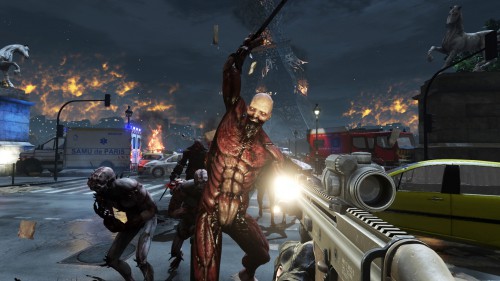 TRIPWIRE INTERACTIVE MAKES an entertaining sequel to its first Killing Floor game. The gameplay includes fighting off hordes of zombie-like creatures, named “zeds”, using firearms in a bloody battle.
TRIPWIRE INTERACTIVE MAKES an entertaining sequel to its first Killing Floor game. The gameplay includes fighting off hordes of zombie-like creatures, named “zeds”, using firearms in a bloody battle.David’s Take:
Killing Floor 2 is the sequel to Killing Floor, which was released by Tripwire Interactive in 2005, and is a first person shooter that works exclusively as a “PvE” game where players band together to fight off increasing numbers of weird zombies called “zeds.” Each round, the players are awarded money for their kills and can use that money to buy better weapons and body armor, fighting until they reach the boss after a set number of rounds. Pro-tip: never forget the body armor.
This is a decent premise for a game, and if you look at my Steam record, Killing Floor is twelfth on the list of games I’ve spent the most time in, so clearly there’s something there. The real uniqueness to both games in the franchise, and therefore the source of replayability, comes in how each player selects a sort of perk set that alters how they play. It isn’t a class system, because there are no weapon or ability restrictions, but a medic can use the healing ability a max of 200 percent faster and 50 percent more effectively. Another example: everyone can buy and use any of the shotguns, but when a fully leveled support character wields one, they do 25 percent more damage and their shots pierce 635 percent more. You level your place in each of these perk sets, earning unique rewards like free body armor, the ability to drop ammo, or even further bonus damage based on the set.
Overall, I think it’s a decent game. In my opinion, it’s a great thing to share with friends over a beer. It gets a little repetitive, but it’s a real test of skill to defeat the boss and jump to the next difficulty level. The game is fairly polished, but the developers have explicitly stated that we can expect six new and different perk sets, alongside new maps both when the developers release them and the map making community gets rolling, so the game is only going to get better, and it’s solid right now.
Here is the kicker though, the game is 30 bucks. It’s a well developed and supported game with very good visuals and an active community, and it is going for half the cost of similar games. If you like shooters and if you’re a fan of “horde-mode” style game, I say buy it. If a horror theme and a very bloody style bother you, then don’t.
Ethan’s Take:
In case you haven’t played the original Killing Floor, the game takes place in Europe where the company Horzine Biotech’s experiments have gone awry, causing a massive outbreak of these cloned creatures called “zeds.” You are part of a group of civilians and mercenaries who have banded together to fight against the outbreak. To do this, you willingly enter “zed-laden hot zones” to exterminate all zeds. On April 21, Tripwire Interactive released Killing Floor 2, which is a major overhaul of the original Killing Floor.
The game starts with you dropped off in the middle of the “hot zone.” From there, you fight wave after wave of zeds until you reach the final boss, who will most likely kill your entire team, assuming your team was good enough to get to the final boss in the first place.
One of the key features of Killing Floor 2 that I think is pretty cool is that instead of making the zeds more bullet absorbent as you increase the level/progress through the waves, they make the zeds act more intelligently/aggressively. Basically, instead of having to empty an entire magazine into a zed to kill it, the zeds move so fast that it becomes difficult to shoot them before you have an entire horde clawing at you. This makes it ever so satisfying to headshot a zed and see its head explode.
Killing Floor 2 brings a major update to the graphics and animations of the game. When reviewing the game, I switched back and forth between the original and KF2. The difference is night and day. KF really looks like an older game with boxier graphics and repetitive animations. KF2 upgrades its game engine from Unreal Engine 2 to a “heavily modified” Unreal Engine 3, enabling life-like graphics. These new graphical changes include generally improved rendering quality and textures, persistent gore (which is awesome and disgusting at the same time), and adaptive lighting. In regards to adaptive lighting, it is not only a visual effect; it affects gameplay, because the longer you stay in one locations, the darker it becomes as your stray bullets and explosions start to knock out light bulbs. The game’s animations are also pretty spectacular. In order to revamp the old animations, Tripwire Interactive went full out and did high-speed motion captures for all zeds, players, and weapons. This gives all the animations super smooth and realistic movement that was not seen in the original. Plus, it’s more fun because, rather than each zed dying the same way each time, they crumple to ground in hundreds of different ways based on how you kill them!
The game also adds new types of zeds and three beautiful new maps to play on. I must note that the game is still in development and is only available for early access, which means maps, weapons, new bosses, and more are still to be added!
David’s rating: 8.5/10
Ethan’s rating: 9/10
